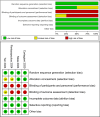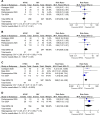High flow nasal therapy versus noninvasive ventilation for AECOPD with acute hypercapnic respiratory failure: a meta-analysis of randomized controlled trials
- PMID: 40360910
- PMCID: PMC12075079
- DOI: 10.1186/s13613-025-01480-w
High flow nasal therapy versus noninvasive ventilation for AECOPD with acute hypercapnic respiratory failure: a meta-analysis of randomized controlled trials
Abstract
Background: Guidelines recommend the use of noninvasive ventilation (NIV) and high-flow nasal cannula (HFNC) in patients with chronic obstructive pulmonary disease (COPD) and hypercapnic acute respiratory failure (ARF). It is unclear whether HFNC is noninferior to NIV in terms of the rate of tracheal intubation or mortality. This meta-analysis aimed to compare the efficacy of HFNC and NIV in patients with AECOPD and hypercapnic ARF.
Methods: A systematic search was made of PubMed, Embase, Cochrane Library, and clinicaltrials.gov, without language restrictions. Randomized controlled trials (RCTs) on treatment of hypercapnic AECOPD with HFNC, compared with NIV, were reviewed. Estimated effects of included studies were pooled as risk ratios (RRs), with 95% confidence intervals (CIs).
Results: Four RCTs (enrolling 486 patients) met the inclusion criteria. There was no statistically significant difference in all-cause mortality (RR 0.97, 95% CI 0.56 to 1.68), and intubation rate (RR 1.67, 95% CI 0.99 to 2.83) between the two groups. The treatment switch rate (RR 2.60, 95% CI 1.54 to 4.38) and treatment failure rate (RR 1.64, 95% CI 1.04 to 2.60) were significantly lower in NIV groups.
Conclusions: Compared with NIV, HFNC was not associated with increased mortality and intubation rate. More patients receiving HFNC oxygen therapy experienced treatment failure and switched to NIV, which may mask the fact that HFNC is inferior to NIV in patients with AECOPD and hypercapnic ARF.
Keywords: COPD; HFNC; Mortality; NIV.
© 2025. The Author(s).
Conflict of interest statement
Declarations. Ethics approval and consent to participate: Not applicable. Consent for publication: Not applicable. Competing interests: None of the authors has a competing interests to declare.
Figures
Similar articles
-
High flow nasal cannula oxygen therapy versus non-invasive ventilation for acute exacerbations of chronic obstructive pulmonary disease with acute-moderate hypercapnic respiratory failure: a randomized controlled non-inferiority trial.Crit Care. 2024 Jul 18;28(1):250. doi: 10.1186/s13054-024-05040-9. Crit Care. 2024. PMID: 39026242 Free PMC article. Clinical Trial.
-
High-flow nasal cannula versus non-invasive ventilation for acute hypercapnic respiratory failure in adults: a systematic review and meta-analysis of randomized trials.Crit Care. 2022 Nov 9;26(1):348. doi: 10.1186/s13054-022-04218-3. Crit Care. 2022. PMID: 36352457 Free PMC article.
-
Comparison of High Flow Nasal Therapy with Non-Invasive Ventilation and Conventional Oxygen Therapy for Acute Hypercapnic Respiratory Failure: A Meta-Analysis of Randomized Controlled Trials.Int J Chron Obstruct Pulmon Dis. 2023 May 22;18:955-973. doi: 10.2147/COPD.S410958. eCollection 2023. Int J Chron Obstruct Pulmon Dis. 2023. PMID: 37251703 Free PMC article. Review.
-
High-flow nasal cannula oxygen therapy versus non-invasive ventilation for chronic obstructive pulmonary disease patients after extubation: a multicenter, randomized controlled trial.Crit Care. 2020 Aug 6;24(1):489. doi: 10.1186/s13054-020-03214-9. Crit Care. 2020. PMID: 32762701 Free PMC article. Clinical Trial.
-
High-Flow Nasal Oxygen versus Noninvasive Ventilation in Acute Exacerbation of Chronic Obstructive Pulmonary Disease Patients: A Meta-Analysis of Randomized Controlled Trials.Can Respir J. 2023 Jun 30;2023:7707010. doi: 10.1155/2023/7707010. eCollection 2023. Can Respir J. 2023. PMID: 37426578 Free PMC article.
Cited by
-
Is high flow nasal therapy still warranted for patients with AECOPD and acute hypercapnic respiratory failure?Ann Intensive Care. 2025 Jul 7;15(1):89. doi: 10.1186/s13613-025-01511-6. Ann Intensive Care. 2025. PMID: 40622643 Free PMC article. No abstract available.
-
High-flow nasal therapy versus non-invasive ventilation for AECOPD: navigating beyond a simple choice- are we asking the right questions??Ann Intensive Care. 2025 Jul 2;15(1):87. doi: 10.1186/s13613-025-01510-7. Ann Intensive Care. 2025. PMID: 40601166 Free PMC article. No abstract available.
-
Clinical characteristics and economic burden of hospitalized patients with acute exacerbation of chronic obstructive pulmonary disease in the Chinese Yi population.Front Med (Lausanne). 2025 Jul 31;12:1519102. doi: 10.3389/fmed.2025.1519102. eCollection 2025. Front Med (Lausanne). 2025. PMID: 40823562 Free PMC article.
References
-
- Vogelmeier CF, Criner GJ, Martinez FJ, et al. Global strategy for the diagnosis, management, and prevention of chronic obstructive lung disease 2017 report gold executive summary. Am J Res Critical Care medicine. 2017;195(5):557–82. - PubMed
-
- Rochwerg B, Brochard L, Elliott MW, et al. Official ERS/ATS clinical practice guidelines: noninvasive ventilation for acute respiratory failure. Eur Res J. 2017;50(2):1602426. - PubMed
-
- Bruni A, Garofalo E, Cammarota G, et al. High flow through nasal cannula in stable and exacerbated chronic obstructive pulmonary disease patients. Rev Recent Clin Trials. 2019;14(4):247–60. - PubMed
-
- Pisani L, Vega ML. Use of nasal high flow in stable COPD: rationale and physiology. COPD. 2017;14(3):346–50. - PubMed
Publication types
LinkOut - more resources
Full Text Sources
Miscellaneous




